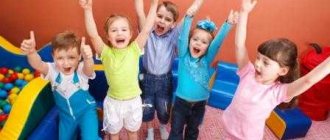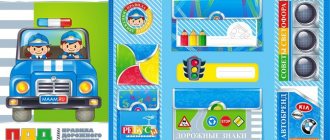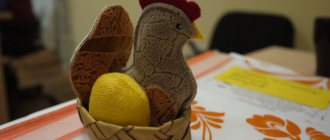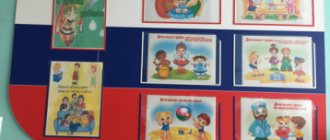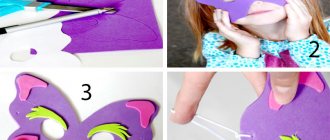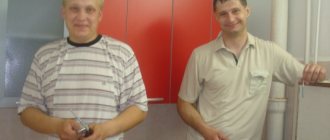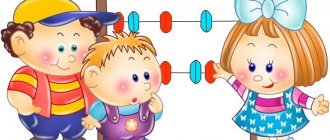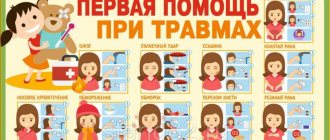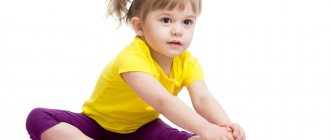Sources:
1. https://www. mbdou-teremok. ru/fizkultura/2016-03-24/nestandartnoe-fizkulturnoe-oborudovanie-svoimi-rukami.
2. https://www. maam. ru/detskijsad/prezentacija-ispolzovanie-nestandartnogo-oborudovanija-po-fizicheskomu-vospitaniyu-v-rabote-s-detmi. html.
Municipal budgetary preschool educational institution, general developmental kindergarten No. 11 “Firefly” of the municipal formation Timashevsky district
Guidelines for
kindergarten teachers
Developed by: teacher MBDOU d/s No. 11
"BILBOKE"
Material: the top of plastic bottles, a Kinder Surprise container or ball, colored thread or ribbon.
Goal: Improving the ability to throw an object up or catch it; develop the eye, reaction speed, coordination of movements of the forearm and fingers, dexterity, accuracy, eye, arbitrariness of behavior, reaction speed. Cultivating perseverance, perseverance, a positive spirit of competition, developing self-control skills.
Use case: Children throw the container up and catch it with a bottle. If you caught it, well done! Games “Who is the most dexterous?”, “Hit the target”, games of a competitive nature.
The purpose of these guidelines is to increase children's interest in physical education, create a need for independent action, and also attract the attention of parents to the problem of maintaining children's health.
It's no secret that the health of the child comes first for every parent. The most effective and affordable means of increasing health potential is physical education and, above all, physical activity. In practice, we are convinced of a decrease in children’s interest in physical activity, their inactivity, and reluctance to take part in outdoor games. Which leads to an increase in morbidity.
How can we make the world of movements truly attractive and interesting for children and parents? To solve this problem, in our group “Semitsvetik”, we use non-standard equipment made by parents, children and teachers with their own hands, which allows you to quickly and efficiently develop motor skills and abilities and helps to increase interest in physical education activities, making children’s movements more diverse, develop creativity and imagination.
Classes with non-standard equipment can be both entertaining and training in nature; they can be organized in the form of game, plot, thematic, educational and training sessions. The novelty lies in the unusual shape and colorfulness of non-standard equipment, which attract the attention of children and increase their interest in performing basic movements and exercises and contribute to a high emotional tone during classes.
The manufactured non-standard equipment is small-sized and quite versatile, and is easy to process. It is easily transformed with minimal time and can be used both indoors and outdoors.
Non-standard equipment is an additional incentive to intensify physical education and health activities. Therefore, it is never superfluous and boring. For teachers and parents, I offer several examples of non-standard physical education equipment that you can easily make with your own hands.
Games with non-standard equipment for physical education and health work with children
Transcript
1 Games with non-standard equipment for physical education and health work with children The use of exercise equipment increases muscle tone, improves blood circulation, and activates redox processes in muscles, joints, and tissues. Massagers can be used in the process of performing general developmental exercises, during gymnastics after sleep, exercise machines during physical education events and free activities of children, both in a group and on a walk. Old ties are stuffed with cotton wool or padding polyester, and eyes are sewn on from buttons. Use: for various types of walking, running, jumping. Goal: development of dexterity, coordination of movement, balance.
2 Holes are drilled on the sides of 2 small plastic buckets, and a tape or rope is inserted at the level of the child’s outstretched arm. Use: children stand with their feet on inverted buckets, holding the ribbons with their hands, and walk on them as if on stilts. Goal: development of agility, endurance, balance.
3 Plastic caps from plastic bottles and used felt-tip pens of different colors are attached to the fabric with the inner surface up. Use: foot massage. Goal: prevention of flat feet.
4 A football field is made from a shallow box (for example, a candy box). The halves of the “Kinder Surprise” act as gates. Soccer ball bead or pea. Usage: two players play, blowing on the “ball” through a thin tube, thereby trying to score a goal against the opponent’s goal. Goal: developing proper breathing skills.
5 The box contains feathers of different sizes. Usage: blow on the feather so that it stays in the air as long as possible. Goal: developing proper breathing skills.
6 Holes are made in a plastic bottle. Confetti, finely chopped polystyrene foam, foil, and paper are poured inside. A breathing tube is inserted into the hole in the plug. Usage: breathing exercise - blow into a tube inserted into a cork. Goal: development of the respiratory system.
7 The boxes contain sea pebbles, small cones or beans. Use: Pick up spilled material on the floor with your toes as quickly as possible. Goal: prevention of flat feet.
8 A plastic bottle is tightly filled with balls rolled from candy wrappers. Use: tapping the back, shoulders. Purpose: massage of the back and upper shoulder girdle.
9 Option 1. The box contains multi-colored buttons. Use: collect buttons scattered on the floor using your feet, lay out a pattern, figure, ornament from the buttons. Option 2. Used felt-tip pens, pencils, sticks of different colors and lengths. Usage: Use the sticks to create the desired pattern with your toes. Goal: prevention of flat feet.
10 Bracelets of different colors are made from beads and old felt-tip pens. Use: 1) for quickly dividing children into subgroups according to the color of the bracelets, 2) for exercises with cross coordination (bracelets are worn, for example, on the right hand and left leg).
11 Consists of “Kinder surprise” capsules tightly strung on a fishing line, with two handles (used felt-tip pens) on the sides. Use: Convenient for massaging the neck, head, upper shoulder girdle, back, chest, legs.
12 It is made from multi-colored plastic corks and rings, taken from the neck of a plastic bottle and turned with the spines outward. The corks are glued together and spiky rings are put on them. The handle is attached in such a way that the roller is movable. Use: The spines on the roller are intended for massaging the neck, back, and legs.
13 Made from the top of a plastic bottle. A fishing line (1-3 pcs.) from 20 to 40 cm long is attached to the bottle with a cap, at the end there is a Kinder Surprise capsule or a bottle cap. Use: To hit the target. Goal: Development of dexterity, attention, eye, reaction speed, ability to regulate and coordinate movements, formation of self-control skills.
14 A braid (about 2 m) with a ball or capsule from a Kinder surprise is sewn to the ring. Usage: Option 1. Hold the ring with one or two hands. Twist the cord into the ring as quickly as possible, each time throwing the capsule into the middle of the ring. Option 2. A plastic ring is attached to the doorway at a distance of about 1.5 m from the ground. Hit the ball into the ring. There can be two players, they are located on different sides of the ring. In this case, the task becomes more complicated: the players must not only throw, but also catch the ball. Goal: Development of dexterity, accuracy, coordination of movements.
15 Made from halves of plastic bottles. Use: for playing table tennis. Goal: development of dexterity, eye, coordination of movements.
16 Kitchen mittens, Velcro, soft or tennis ball with Velcro glued to the sides. Usage: Each player wears a mitten on his hand, with Velcro sewn in the middle. Game in pairs: throwing a ball to each other and catching it with a mitten. Goal: Development of coordination of movements, eye, dexterity, ability to play in a team.
17 Use: chips of different colors are offered according to the number of children. Participants can choose one of them if they wish. The training place (or equipment) is indicated by the same chip. Children independently find their projectile or the location of the team. On the back of the chips, numbers may be written indicating the serial number of the team players. Goal: to help children quickly divide into teams, determine the order or place of task completion, increase the motor density of physical education and recreation activities, and promote the formation of interest and need for physical activity.
18 A cord 5m long, threaded through a ring attached to the ceiling. A plastic ball is attached to one end of the cord, and a stick for winding the cord is attached to the other. Usage: The child wraps a cord around a stick, the ball rises to the ceiling. Who is faster? Goal: development of dexterity, fine motor skills of the hands.
19 Made from corrugated paper and cardboard. Attached to a cord with a ring. Option 1 Goal. Teach proper breathing. Take the butterfly by the ring and lift it to the level of your face or secure all the butterflies on one long cord in a horizontal position. Inhale through your nose, and exhale for a long time through your mouth towards the butterfly. (Repeat 3-4 times.) Option 2 Goal. Learn to respond quickly to a signal; practice ease and smoothness of movements; develop spatial orientation. Children hold butterflies by the ring and move around the hall to the music. At the signal “Butterflies, to the flowers!” children plant butterflies on outdoor flowers. You can complicate the task somewhat by setting it to a specific color of butterflies or flowers.
20 Multi-colored ribbons are cut and processed from nylon fabric. Use: 1) for outdoor switchgear, 2) for developing proper breathing skills.
21 A wide elastic band is attached to the plastic grate (for the kitchen sink). Use: Sliding, jumping during sports games, relay races. Goal: development of dexterity, coordination of movements.
22 Multi-colored New Year's rain cut into strips is attached to the stick. Use: 1) for outdoor switchgear or rhythmic gymnastics, 2) for developing proper breathing skills.
23 Made from thick colored paper, attached to sticks so that they can rotate freely. Goal: development of proper breathing skills.
24 Made from green plastic bottles, which are cut and strung on a long stick. Usage: As guides, for decoration, etc.
25 Breathing exercises for working with children Breathing exercises In my work, I often use new techniques. Children love it when they are asked to perform already known exercises, but with new attributes. I would really like to share my ideas with everyone. I would like to show you what breathing exercises I have made for children. We use these simulators to train directed exhalation. The simulator is placed on an open palm, and the child’s task is to deflate it.
26 The child holds the attribute by the ribbon at arm's length. Task: take a long exhale so that the butterfly “flies” and the snowflakes “spin” for as long as possible. The task of the children, holding a lily leaf on their palm, is to blow away the frog. Moreover, if you blow quickly and strongly, it will turn out that the frog will “jump” from the leaf.
27 As in the previous exercise, the children’s task is to blow the bee off the flower. My children and I also love to play football. But our football is unusual - it is “breathing”. Homemade gates made of cardboard are installed on the table. The children's task is to kick the ball into the opponent's goal before he does. My students absolutely love doing these exercises. And we even hold tournaments for breathing football!
28 MK crafts from waste material “Glutton Oh and Ah” Hello, dear colleagues! For Earth Day, our garden hosts an annual competition for crafts made from waste material. This year my daughter and I made two gluttons Okha and Akha; in addition to funny figures, it is also a throwing simulator. The goal of the game is to feed the glutton. The distance for throwing “food” is adjusted depending on the shooter’s accuracy. To make gluttons you need: 1. Plastic bottles - 2 pcs. 2. Milk caps in blue and red. 3. White mineral water caps. 4. Buttons for the pupils. 5. Scissors. 6. Thermal gun. 7. Sequins for “freckles”. 8. Be sure to be in a good mood.
29 Cut out the mouth Using a hot-melt gun, glue on the nose, ears, eyes, freckles
30 Your glutton is ready! Have a good game!
31 Multifunctional physical education equipment “Tasty Cheese” Multifunctional physical education equipment for preschool children “Tasty Cheese” This manual is used to develop general motor skills, physical activity, and eye perception in children of primary preschool age. The child is asked to climb through the goal, roll the ball, hit the hoop with the ball, and hit the target. The brightness and novelty of the manual attracts the attention of children. Can be used by teachers in individual work with children. Children also enjoy playing in their free time. During the summer, the allowance can be used outside. To make this manual you will need a sheet of plywood, paint, a simple pencil, and a jigsaw. A drawing is drawn on plywood with a simple pencil, then the drawing is cut out with a jigsaw, and stands are also cut out to secure the aid. Then the cheese and the mouse are painted with paints. The height of the benefit can be very varied. You can glue hooks onto the plywood to hang ribbons and a circle to hit the target.
32
33
34
"FUNNY PENCILS"
Material: the equipment is made of colored pencils or felt-tip pens, the Kinder container is a surprise.
Purpose: to promote the prevention of flat feet, foot massage. Improves blood circulation in fingers, hands and forearms.
Options for use: Palm massage (rotating the barrel of a pencil between the palms), massage of the fingertips, massage of the back and inside of the palm. Foot massage, lifting a pencil with your toes. Use as attributes.
Non-standard sports equipment in preschool educational institutions
Non-standard sports equipment in preschool educational institutions pinned post
- Community Posts
- Search
Non-standard sports equipment in preschool educational institutions pinned post
The use of non-traditional aids in physical education classes
Municipal budgetary preschool educational institution “Kindergarten No. 205 “Novograd” of the city of Cheboksary, Chuvash Republic
Prepared by: physical education instructor Galina Vasilievna Larionova.
Non-standard sports equipment in preschool educational institutions pinned post
Non-traditional do-it-yourself play equipment
The booklet presents play equipment for children, made together with parents, which we use to preserve and strengthen the health of children. All equipment is made from waste material.
MBDOU "Tambov kindergarten" in the village of Tambov, Romanovsky district, Altai Territory
Educator: Proskurina Evgenia Nikolaevna
"MASSAGE GLOVES"
Material: Gloves, beads, buttons, threads and needles.
Goal: Increasing the overall tone of the body (help to have a positive effect on the growth and development of the child’s body, relieve fatigue, improve blood circulation, calm the nervous system of preschoolers). Strengthening the immune system and improving the emotional state of the child.
Use: Children massage all parts of the body for themselves and each other.
"BAGS"
Material: Thick fabric or leatherette, sand or salt 150 and 200 grams.
Goal: Development of throwing skills from different distances and from different positions, development of arm strength. Fostering a positive competitive spirit.
Use: For outdoor switchgear classes and outdoor games. The game “Who will throw further?”, “Who will collect it faster?”, “Funny catch-up”. Children stand in a circle and pass 2 bags to each other. Purpose of the game: the bags should not meet, catch up with each other. In competitions, as a relay baton.
"AIR FOOTBALL"
Material: Box covered with self-adhesive film, goal cups, foil for the ball and straws.
Goal: Develop breathing, exhalation power. Cultivating perseverance, perseverance, and a positive spirit of competition.
Use: in gaming activities.
Progress of the game:
The game is installed on the table. There are 1 player on both sides, armed with straws. The balls are placed in the center of the playing field. The players' task is to score the most goals against the opponent's goal. At the same time, they should not touch the ball with their hands, but can only blow on it through the tubes.
If a player touches the ball with his hand or straw, the opponent receives one extra point. By agreement, the players can introduce some football rules.
"Sport equipment"
Age 6-7 years The set includes 8 cards depicting sports equipment - 48 pictures. For the card you need to print it twice, the second copy is cut into separate pictures. The set also includes 7 cards with a brief description of sports equipment.
Goal To familiarize children with the variety of sports equipment and its purpose. Objectives - To expand knowledge about sports equipment, its purpose, and the types of sports where sports equipment is used. — Develop long-term visual memory and attention. — Cultivate interest in physical education and sports. Before the game , review with the children all the cards depicting sports equipment. Have a conversation about what the sports equipment is called and what it is used for. There are several options for the game: Option 1 Individual game (with a teacher) The child selects a picture and overlays it on the playing field with the same pictures. After the child has found the picture, he must name the sports equipment that is depicted on it. Explain how this equipment can be used. Option 2 Collective game using the playing field and cut cards. 2-8 people + the leader play at the same time. The presenter distributes large cards to the players. The cut cards remain with the presenter. The presenter takes out one card at a time and shows it to the players; the card goes to the player who has it on the playing field, and if the player named the inventory correctly. The winner is the one who is the first to fill his playing card with cards and correctly name the sports equipment where it is used. Option 3 Collective game using only cut cards. From 2 to 8 children play at the same time. All cards are shuffled and laid out in a deck, face down. Players take turns revealing cards in a clockwise order. The player who opened the card must name the sports equipment; if the equipment is named correctly, the player takes the card for himself. If the inventory is not guessed, the card is placed face down next to the deck, and the turn passes to the next player. After playing the first deck, players play the second. The one with the most cards at the end of the game wins. Complication - the card can be picked up if the player tells where the equipment is used. Looks like that:
Here you can download the didactic game Sports equipment for color printing in PDF format
Didactic game in physical education for preschoolers paired cards
